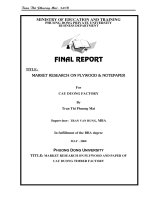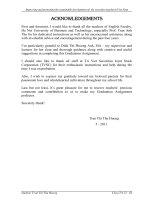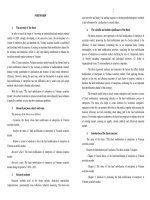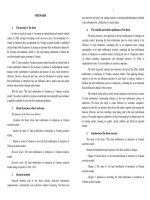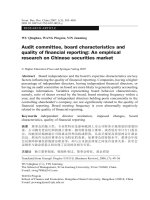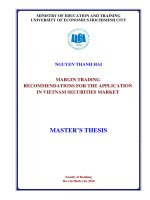securities market topic trading regulations on hnx and hsx
Bạn đang xem bản rút gọn của tài liệu. Xem và tải ngay bản đầy đủ của tài liệu tại đây (2.22 MB, 18 trang )
<span class="text_page_counter">Trang 1</span><div class="page_container" data-page="1">
<b>TRƯỜNG ĐẠI HỌC KINH TẾ QUỐC DÂN</b>
<b>---***---SECURITIES MARKET</b>
<i><b>TOPIC: Trading regulations on HNX and HSX</b></i>
<b> Class: Corporate Finance CLC 62B</b>
<b>Group 7:</b>Phan Thị Phương ThảoLê Minh Tú
Đinh Thị Minh PhươngTrịnh Duy HưngNguyễn Thị Phương MaiTăng Ngọc AnhHoàng Minh Đạo
<b>HANOI, 2022</b>
<b> </b><b>TABLE OF CONTENTS</b>
<b>I.Vietnam Stock Exchange</b>
</div><span class="text_page_counter">Trang 2</span><div class="page_container" data-page="2"><b>1. Introduction of Vietnam Stock Exchange</b>
<b>2. Advantages and Challenges of merging HNX and HSX</b>
<b>II.Listing on the stock exchange1. Definition</b>
<b>2. Listing guarantee3. Listing requirement</b>
<b>III.Security trading</b>
<b>1. Concepts that need understanding2. Concepts applied in practice</b>
<b>a) Priceb) Trading unitc) Tick size</b>
<b>d) Payment regulation3. Stock trading system4. Trading method5. Order matching method</b>
<b>IV.Trading activities on HNX and HSX1. Advantages</b>
<b>2. Disadvantages </b>
<b>I. Vietnam Stock Exchange</b>
<b>1. Introduction of Vietnam Stock Exchange</b>
<i><b>a) Model</b></i>
According to Decision No 37/2020, VNX operates under the mother-child model based onthe reorganization of HNX and HoSE with the model of a single member limited liabilitycompany with 100% charter capital held by the State, which will be roughly 3 trillion VND. - Having legal status and own seal; be qualified for opening accounts in Vietnam dong andforeign currencies at the State Treasury and domestic commercial banks
- Independent accounting, implementing financial regimes, statistical reporting, accounting,auditing and financial obligations as prescribed by law.
<i><b>b) Member of Vietnam Stock Exchange</b></i>
Trading member means a securities company that is approved by the Vietnam StockExchange to become a trading member, which includes stockbrokers and securities dealers,meeting the following standards: stated as strong financial status, good equipment and highprofessional qualifications, capable of performing professional activities on securities.Special trading members are commercial banks, foreign bank branches and otherorganizations approved by the Vietnam Stock Exchange to become special trading members.
</div><span class="text_page_counter">Trang 3</span><div class="page_container" data-page="3">1. To elaborate strategies, investment and development plans, 5-year production and businessplans and annual production and business plans for submission to competent authorities forapproval according to regulations.
2. To promulgate regulations on securities listing, securities trading, information disclosure,trading members and other professional regulations related to the organization and operationof the securities trading market after approved by the State Securities Commission.3. Supervision of HOSE àd HNX in implementing regulations on professional activities;general supervision of the securities market according to the provisions of law;
4. Orientation for development of information technology system, orientation fordevelopment of new technologies and new products.
5. Supporting market development through the provision of infrastructure services, training,knowledge dissemination...
6. Act as a mediator at the request of transaction members when a dispute arises.
7. To cooperate internationally on securities and the stock market, to be the focal point forparticipating in international organizations on the stock market.
8. To manage the subsidiaries of the Vietnam Stock Exchange in accordance with the law andthe operation charter of the Vietnam Stock Exchange;
9. Other tasks as prescribed by law and regulations of competent authorities.
<b>2. Advantages & Challenge of the merger of HNX and HSX</b>
<i><b>a) Advantages</b></i>
The merger into an exchange can facilitate the clearing of securities and moneytransactions will be centralized in one focal point, making it easier for the State SecuritiesCommission to manage and operate. , the monitoring of activities
The consolidation will also save a lot of costs during the operation of the Vietnamesestock market. For state management agencies, it will save system operating costs, salary costsof the entire personnel system of an exchange. For securities companies, membership feeswill only be paid to a stock exchange. The cost of leasing transmission lines of technologyequipment will also decrease with the consolidation. Theoretically, a lot of expenses would besaved by 50% when merging two stock exchanges
<i><b>b) Challenges</b></i>
The first challenge is the issue of charter capital of listed companies when merging twoexchanges. Currently, the charter capital of companies listed on HOSE is `120 billion VNDand on HNX is 30 billion VND. So when merging, what standard will the two stockexchanges follow when the business nature of these two exchanges is completely different?
The second challenge when merging two exchanges is that currently, the legal documentsgoverning HOSE and HNX are different, so in order to merge, it is necessary to have legaldocuments for this merger. While Vietnam's stock market currently needs stability to develop,to avoid sudden changes that are detrimental to the market, the introduction andimplementation of too many legal documents for the current market is not enough. This reallyneeds careful consideration
</div><span class="text_page_counter">Trang 4</span><div class="page_container" data-page="4">The third challenge when merging two exchanges is the problem of technologicalequipment. Because when consolidating, the volume of traded goods will increase, requiringmore modern technological equipment to meet the operating requirements of the system,which leads to the member securities companies also upgrade and will incur additional costsand the possibility of unexpected problems due to technological equipment failure is likely tobe higher.
<b>II.Listing on the stock exchange</b>
Listing of securities is the process of identifying qualified securities to be traded on theStock Exchange provided that the company fully meets the standards set by the StockExchange.
Listing guarantee means a guarantee organization to the issuer to carry out theprocedures before the securities offering, purchase or purchase part or all of the securities ofthe issuer for resale. , or buy the remaining undistributed securities of the issuer, or assist theissuer in the distribution of securities to the public.
<b>2.Listing requirement:</b>
<i><b>a) Conditions for listing securities on HOSE exchange</b></i>
● Minimum charter capital 120 billion
● Operating time is at least 2 years in the form of a Joint Stock Company● At least 20% of voting shares held by at least 300 non-major shareholders
● In the last 2 consecutive years of operation, it must have Profit on capital: the mostrecent is equal to or above 5%
● No debt overdue for more than 1 year
● No accumulated loss up to the time of listing registration
● The company does not violate the law as well as the terms of accounting and financialreporting
● The company and its legal representative have not been handled for violations within 02years from the time of listing registration due to the performance of prohibited acts insecurities and securities market activities.
<i><b>b) Conditions for listing securities on HNX exchange</b></i>
● Minimum charter capital 30 billion
● Operating At least 1 year in the form of a Joint Stock Company● At least 15% of voting shares held by at least 300 non-major shareholders
● The previous year must have Return on capital: the most recent is equal to or above 5%● No debt overdue for more than 1 year
● No accumulated loss up to the time of listing registration
● The company does not violate the law as well as the terms of accounting and financialreporting
</div><span class="text_page_counter">Trang 5</span><div class="page_container" data-page="5">● The company and its legal representative have not been handled for violations within 02years from the time of listing registration due to the performance of prohibited acts insecurities and securities market activities.
<i><b>c) Order and procedures for listing securities</b></i>
● Step 1: Submit the application for registration to the Stock Exchange.● Step 2: The Stock Exchange appraises the dossier.
● Step 3: Submit an application for official listing to the Stock Exchange.● Step 4: The Stock Exchange conducts the inspection.
● Step 5: Approved by the Stock Exchange.● Step 6: Open listing.
According to Article 111 of Decree 155/2020/ND-CP:
Within 30 days from the date of receipt of a complete and valid listing registrationdossier, the Stock Exchange shall issue a decision approving the listing; In case of refusal, itmust reply in writing and clearly state the reason.
Within 90 days from the date of being approved for listing, the organization registeringfor listing must put securities into trading.
<i><b>d) Securities listing fee in Vietnam </b></i>
Previously, in Circular 127/2018/TT-BTC, the fee for registration of securities listing forthe first time was 10 million VND/listed company; Additional listing times have a fee of 5million VND/time. However, until Circular 14/2020/TT-BTC amending a number of articlesof Circular 127, this fee was waived for enterprises registering for listing for the first time.
Circular 127 also stipulates that the annual listing management fee for stocks with alisted value of less than VND 100 billion is VND 15 million; from 100 billion to less than500 billion dong is 20 million dong; from 500 billion dong or more is 20 million dong plus0.001% of the listed value but not exceeding 50 million dong. For bonds and fund certificates(listed value at par value) with a listed value of less than VND 80 billion, the fee is VND 15million. Listed value of VND 200 billion or more has a revenue of VND 20 million,0.001%/listed value but not exceeding VND 50 million…
<b>● For stocks</b>
100 billion VND - 500 billion VND 20 million VND
> 500 billion VND 20 million VND + 0.001% of the listed value but notexceeding 50 million VND
<b>● For bonds and fund certificate</b>
</div><span class="text_page_counter">Trang 6</span><div class="page_container" data-page="6"><b> Listed value Annual listing management fee</b>
> 200 billion VND 20 million VND + 0.001% of the listed value but notexceeding 50 million VND
<b>3. Listing situation of enterprises </b>
There are many reasons leading to the delisting of securities, but they are classified intotwo main groups: voluntary delisting and compulsory delisting.
<i><b>● THACO voluntarily cancels listing</b></i>
The State Securities Commission has just announced the cancellation of public companyregistration of Truong Hai Automobile Joint Stock Company (THACO) from January 1,2021. Since retail shareholders own less than 3% of THACO's total voting shares, whichmeans that the 10% requirement of the 2019 Securities Law has not been met, THACO isallowed to delist.
Specifically, the Securities Law 2006 stipulates that a public company is an enterprisethat meets 1 of 3 conditions: (1) has offered shares to the public (2) has listed shares (3) hasfew shares. at least 100 shareholders, excluding professional securities investors and havecontributed charter capital of VND 10 billion or more.
The Securities Law 2019 effective from January 1, 2021 has "raised the standard" ofpublic companies, whereby a public company is a joint-stock company in one of two cases:(1) having charter capital. has contributed at least VND 30 billion and has at least 10% of thevoting shares held by at least 100 investors who are not major shareholders, (2) hassuccessfully offered shares Initial public offering through registration with the StateSecurities Commission.
With this regulation and the fact that at the time of closing the list of shareholders onMarch 3, 2021 by the Vietnam Securities Depository, THACO currently has 2,172shareholders, of which retail shareholders own less than 2,172 shareholders. 3% of THACO'stotal voting shares, which means that it has not met the 10% requirement of the SecuritiesLaw 2019. Therefore, THACO has consulted the State Securities Commission about notmeeting the conditions of being a company. the public according to regulations
<i><b>● RIC is forced to delist</b></i>
The Ho Chi Minh City Stock Exchange (HoSE) has just announced that RIC shares ofHoang Gia International Joint Stock Company have been subject to mandatory delisting dueto continuous losses for 3 consecutive years.
</div><span class="text_page_counter">Trang 7</span><div class="page_container" data-page="7">Royal International Joint Stock Company is the owner of the Royal Ha Long casino hotel- the only casino business with shares traded on the stock exchange. According to the auditedfinancial statements for 2019, 2020, the profit after tax in those years was negative 72.79billion dong and 81.54 billion dong, respectively. In 2021 alone, RIC suffered a loss of morethan VND 102 billion and this is also the third year in a row that the company has made aloss. By the end of 2021, Hoang Gia International has accumulated a loss of 412 billion dong.
<i><b>● HU1 has been put under control and is likely to be delisted</b></i>
With the continuous appearance of an excepted audit opinion on the financial statements,the Ho Chi Minh City Stock Exchange (HOSE) has written a note to HUD1 Investment andConstruction Joint Stock Company (HOSE: HU1) on the possibility of shares being delisted.
Specifically, according to the document from HOSE, HU1 stock has been put undercontrol since April 13, 2022 for the reason that the audit organization has an exception for 2consecutive years on the financial statements of 2020 and 2021. According to regulations,shares of a public company will be delisted if there is an audit organization that does notaccept the audit, or refuses to comment on the latest year's financial statements, or have anexcepted audit opinion on the annual financial statements for 3 consecutive years. Therefore,HOSE issued a note to delist with HU1, if the audited financial statements of 2022 continueto show an exception.
According to HU1's reviewed semi-annual financial statement 2022, HU1's subsidiary,HUD1.02 Investment and Construction Joint Stock Company, has ceased operations, whilethe data used to establish the Joint Stock Company has ceased operations. Semi-annualconsolidation is for the year 2021, unaudited. This is the basis for the audit unit, CPAVietnam, to make an exception.
After the first 6 months of 2022, HU1 reported a profit after tax of more than 2.3 billiondong, while the same period lost nearly 264 million dong. The company explained the reasonwas the growth in business results and construction revenue in the period. At the same time,
</div><span class="text_page_counter">Trang 8</span><div class="page_container" data-page="8">in the same period of 2021, the parent company made provision for bad debts (VND 4.7billion), resulting in a loss in the 2021 semi-annual financial statement.
<i><b>● Foreign companies listed on Vietnam stock exchange</b></i>
After 19 years from the date of opening for foreign capital flows, there are 11 FDIcompanies participating in Vietnam's stock market, currently 8 companies are listed, and 3other FDI enterprises have been delisted due to business losses
� 3 losing businesses are CYC, RIC, TCR
</div><span class="text_page_counter">Trang 9</span><div class="page_container" data-page="9"><b>III.Securities trading </b>
<b>1.Concepts that need understanding</b>
- Reference price: base price to determine floor price and ceiling price- Floor price: the lowest price that a stock may be sold
- Ceiling price: the highest price that a stock may be sold
- Price range: the highest and lowest prices recorded within a given time on a market- Price range = Reference price +/- (Reference price x Price range %)
- Tick size: minimum price movement of a trading securities
- Trading unit: is the number of shares of a security that is used as the acceptablequantity for trading on an exchange
<b>2.Concepts applies in practicea) HNX:</b>
- MP – Market Price Order: Orders to match at the best counter-bids/asks available inthe market at the time of input and shall match forward to the next best prices available.Market Price Order is only available and effective during the Continuous Matching period.Should there be no counter LO at the time of input of Market Price Orders, the Market PriceOrders will automatically be canceled.
- Some types of Market Price Orders:
+ MTL - Market-to-Limit: In the case that there are no more counter-bids/asks,remaining unmatched volume of MTL Orders will automatically be changed into LimitOrders
</div><span class="text_page_counter">Trang 10</span><div class="page_container" data-page="10">+ MOK - Match-or-Kill: Order must be executed in its entirety at the time of input;otherwise, the entire order will be canceled.
+ MAK - Match-and-Kill: Order can be executed partially or entirely, and the remainingunmatched order will be canceled.
- ATC – At-the-close: The order at opening price or closing price, which is not given aspecific price, is called ATC. ATC Orders have higher priority to match than Limit Orders(even Limit Orders at Ceiling Price or Floor Price). At the end of the effective session,unmatched ATC Orders or unmatched volume of partially matched ATC Orders willautomatically be canceled.
- PLO - Post Close Order: The buy/sell order at closing price, which is used in session transactions. PLO is matched right after a counter order appears and is automaticallycanceled after the post-session transaction has ended. PLO is not allowed to be input into thesystem when there is no matched order in the continuous order matching session and closingperiodic order matching session.
<i><b>post-● Trading units</b></i>
- For board-lots: 100 shares/ ETFs/ Bonds
- Volume of put-through transactions: From 5,000 shares or ETFs. No quotation unit forput-through transactions.
- Trading unit, minimum trading volume for bond put-through transactions: 01 bond- Trading unit for odd-lot transactions: 01 share, ETFs. Odd-lot securities trading from01 to 99 stocks (volume), ETFs are executed by either continuous order matching or put-through matching method.
- Put-through and odd-lot transactions are not allowed to execute on the first tradingday of newly listed stocks or the re-traded day after 25 days of suspension until the closingprice is determined.
</div>
